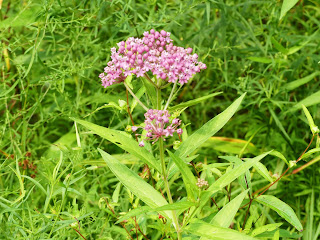Milkweed/Dogbane Communities
I was thinking recently about all the organisms that benefit from milkweed plants. (Some but not all of these also apply to dogbanes.) Just like trees support insects, birds, squirrels, and lichen as either homes or food, on a smaller scale milkweeds provide similar benefits:
- Perhaps their most famous connection is to Monarch butterflies, whose caterpillars feed exclusively on milkweeds (mostly leaves).
- They're not the only lepidopterans whose caterpillars rely on milkweeds; the Milkweed Tussock Moths also eat milkweed (and dogbane).
- It's not unusual to find aphids on milkweed plants. Some aphids like the Oleander Aphid are invasive, but they are insects that frequently feed on milkweed plants. And if aphids are eating milkweed, this is also likely to attract lady beetles that want to eat the aphids. Finally, the aphid poop is a sweet substance called honeydew that frequently causes Sooty Mold to grow. (I don't recall seeing aphids on dogbane, but they're documented to eat dogbane too.)
- Some beetles feed on milkweeds/dogbanes too. Perhaps the most common one is the Red Milkweed Beetle.
- The "villain beetle" in the community is probably the Japanese Beetle, an invasive beetle that damages the flowers and thus damages a milkweed's ability to fertilize and go to seed.
- A showy beetle that's seen more often on dogbane but will also feed on milkweed is the Dogbane Leaf Beetle, certainly one of the shiniest insects in a garden or meadow.
- The other beetle large/conspicuous enough to get my attention is the Swamp Milkweed Leaf Beetle, who despite the specificity of the name will eat a variety of milkweeds.
- True bugs rely on certain milkweeds/dogbanes too. The Large Milkweed Bug eats seeds of the Common Milkweed; this might be the only plant in my area they eat, but outside NJ there are a few other plants they'll eat. Though native insects, they can be detrimental to the spread of milkweeds since they'll eat the milkweed pods and seeds.
- The related Small Milkweed Bug will also eat milkweed seeds, though they have a more varied diet that can include other plants and even insects.
- Finally, once you include pollinators into the community, the size of the community explodes! Lots of bees, wasps, butterflies, moths, flower flies, beetles, and hummingbirds take advantage of lots of flowers in a single spots to get their fill of nectar and/or pollen.
I suspect that if I looked at other native wildflowers closely, I could probably come up with similar posts on them too, though it's impressive all the life that utilizes these particular wildflowers.
The pictured wildflower is a Swamp Milkweed, one of the more colorful of the milkweeds I see fairly frequently.
 |
| July 22, 2021 at Fairview Farm Photo 148401132, (c) jpviolette, some rights reserved (CC BY-NC) |



Comments
Post a Comment